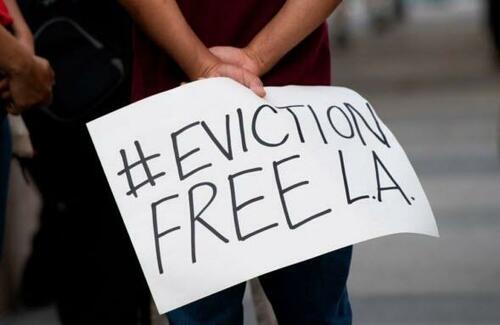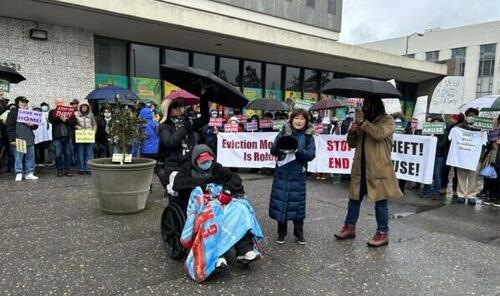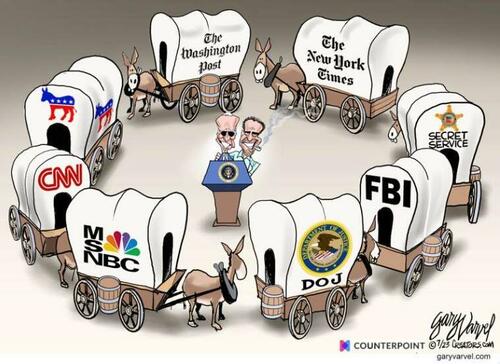Authored by Travis Gillmore via The Epoch Times,
With some of the most expensive rent prices in the nation, Californians pay a disproportionate share of income for housing, and with evictions now returning after nearly three years of moratoriums in certain locations, some property owners and renters are finding themselves in difficult predicaments.

More than 768,000 households are behind on rent in the Golden State, with debts totaling more than $5 billion, putting approximately 721,000 children at risk of eviction, according to the National Equity Atlas—a collaborative data and analytics tool founded by Oakland-based Policy Link and the University of Southern California Equity Research Institute.
Residents in the City of Los Angeles are facing a deadline of Aug. 1 to repay all rental debt accrued between March 2020 and September 2021, with that from October 2021 to January 31, 2023, due by February 2024.
With the first deadline imminent, Mayor Karen Bass and the city council are working to assist overburdened renters with a series of programs allowing applicants to request financial aid.

Renters and housing advocates attend a protest to cancel rent and avoid evictions amid the Coronavirus pandemic in Los Angeles on Aug. 21, 2020. (Valerie Macon/AFP via Getty Images)
Renters make up nearly half of the state’s population, with an estimated 17 million people leasing their homes out of 39.5 million residents, and rising prices are impacting their ability to make ends meet, according to Legislative analyses.
Average rent prices in California are $2,902 across all sizes and property types, according to online real estate listing company Zillow as of July 21.
Based on current listings in many areas like Orange, San Diego, Santa Clara, or San Francisco counties, homes with three bedrooms and space to accommodate a family cost at least $4,000 a month to rent.
Supply and demand are to blame, with less housing available than is needed fueling a progressive increase in rental prices, according to economists.
Rent increase limits for existing tenants were established with the passage in 2019 of Assembly Bill 1482, known as the California Tenant Protection Act, setting a 5 percent plus the cost of inflation or 10 percent, whichever is lower, as the highest adjustment allowed.
New leases are not subject to the same protection, thus further incentivizing landlords to evict slow or non-paying and at-fault tenants, according to experts.

A “For Lease” sign is posted in front of a house available for rent in Los Angeles on March 15, 2022. (Mario Tama/Getty Images)
Meanwhile, stakeholders on both sides of the rental equation have raised questions about various regulations instituted during the pandemic.
Some landlords report dealing with stressful moments when renters were not paying, and they had no legal recourse to evict for non-payment, yet their mortgage payments continued to be due monthly.
“It put all the headache on the property owner,” John Morgan, owner of multiple rental properties in Northern California, told The Epoch Times.
“I understand some tenants were unable to pay. But some of these situations we saw across the state were people taking advantage of the moratorium. They just stopped paying and used the money to fund a better lifestyle.”
The California Apartment Association has brought attention to the matter by filing lawsuits to limit renter protection mandates, lobbying lawmakers, and presenting stories of landlords that were owed significant sums—one more than $108,000—in back rent from families that simply chose to stop paying because they could not be evicted.
Now with the state COVID moratoriums rescinded in June 2022 and municipal protections slowly coming to a close—with the exception of San Francisco, which is extending its policies for some low-income residents—evictions are starting to climb.
“We don’t ever want to evict anyone, but we have bills to pay, and when they’re mounting up, it weighs on our family,” Mr. Morgan said.
“If I can’t pay the mortgage, I don’t have a house to offer for rent.”

Dozens of people hold up signs protesting against an eviction moratorium while a property owner sitting in a wheelchair continues his hunger strike in Oakland, Calif., on Feb. 26, 2023. (Xue Mingzhu/The Epoch Times)
On the other hand, renters are faced with inflationary pressures and an uncertain economic future, with layoffs occurring in high-paying technology and finance fields in the state this year, and some rural areas experiencing economic upheaval with mounting losses reported by many businesses involved in the cannabis industry.
“It’s been tougher to find a job and steady income this year than at any time since I moved here in 2009,” Maria Aguilera, a restaurant employee and mother of two living in Mendocino County, told The Epoch Times.
“Everything is changing, people have less money to spend, so we’re making less in tips. Most of my money goes to rent and utilities because housing is so expensive.”
Recognizing the issues facing renters in the state, a group of lawmakers—themselves renters—formed the Renters Caucus, a bicameral group of five Democrats dedicated to addressing rental-related housing concerns.
Chaired by Assemblyman Matt Haney (D-San Francisco), the caucus includes fellow Assemblymembers Alex Lee (D-Milpitas), Isaac Bryan (D-Culver City), Tasha Boerner (D-Carlsbad), and Sen. Aisha Wahab (D-Fremont).
Several proposals were introduced this year to strengthen renters’ protection, with one such measure, Senate Bill 567—authored by Sen. María Elena Durazo (D-Los Angeles) and designed to limit rent increases to 5 percent annually—finding itself watered down in the legislative process. With price caps now stripped from its text, the bill will next be considered by the Assembly Appropriations Committee.

Apartments in Santa Ana, Calif., on Feb. 10, 2021. (John Fredricks/The Epoch Times)
Assembly Bill 12, introduced by Mr. Haney, the renters’ caucus chair, would reduce the amount of security deposit allowable from two months’ rent for an unfurnished dwelling and three months’ for furnished to the amount equal to one month’s rent for any new residential lease.
The bill passed the Assembly and all Senate committees and will be debated on the Senate floor once legislative meetings resume in August following the summer recess.
The author notes the importance of the bill in the analysis provided to the Legislature, as high up-front costs prevent some residents from obtaining housing, citing statistics that show average deposits of $8,000 in Los Angeles and $10,000 in San Francisco. Most landlords require first and last month along with a deposit when securing a lease.
“While many families are able to afford their monthly rent, the requirement for two or three months’ rent solely for a security deposit places a financial burden on many who cannot afford it,” Mr. Haney argued in support of the bill in the Assembly’s analysis. “As a result, many families have to choose between acquiring more debt to afford their security deposit or not being approved for their much-needed housing.”













